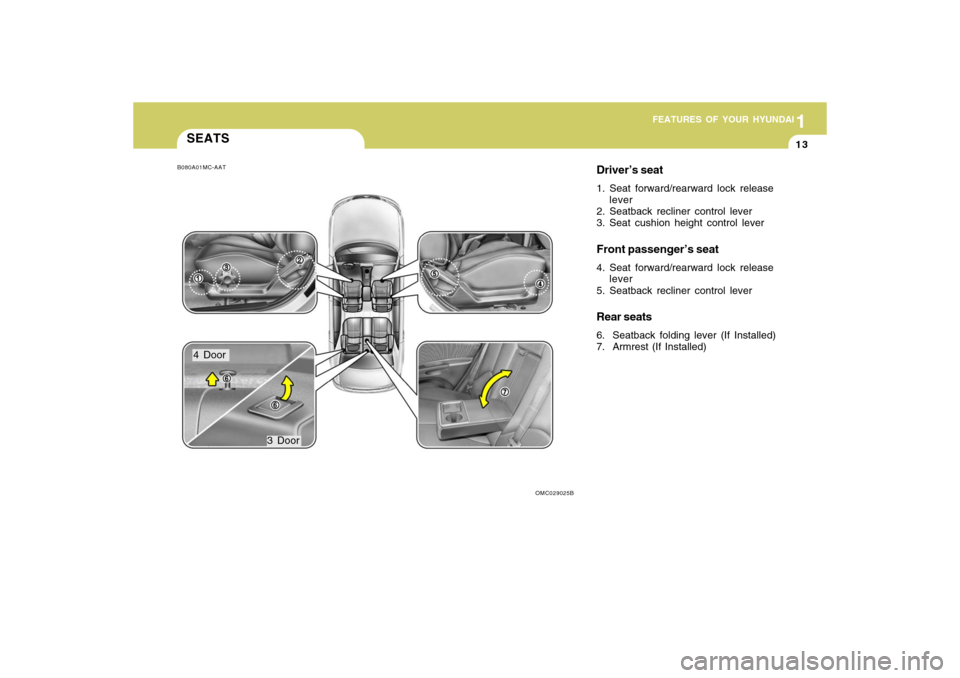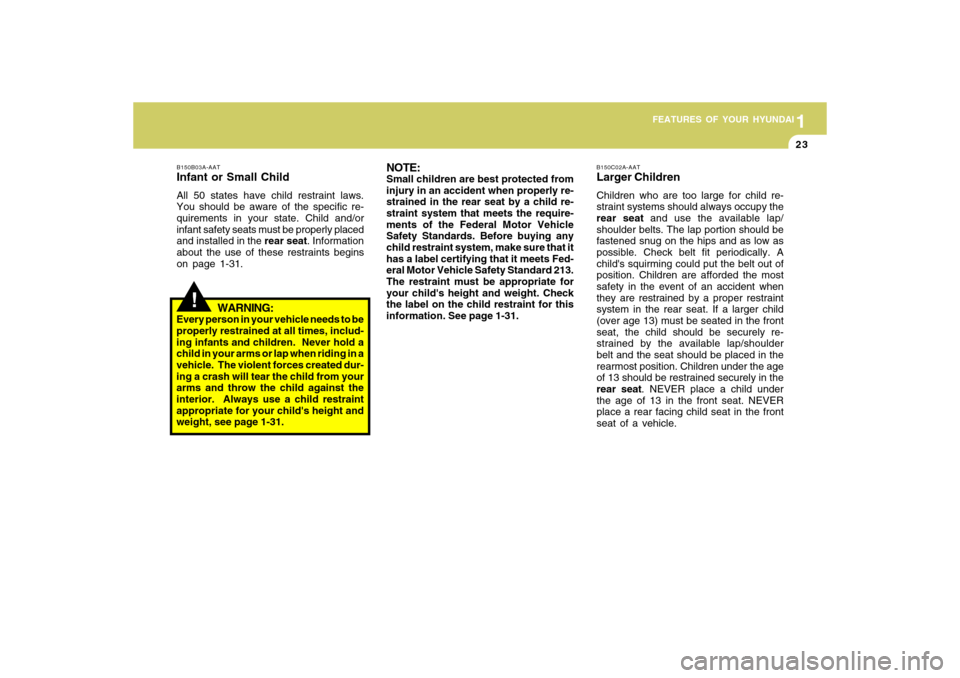2009 Hyundai Accent seats
[x] Cancel search: seatsPage 11 of 266

FEATURES OF YOUR HYUNDAI
1
Fuel Recommendations ................................................ 1-2
Breaking in Your New Hyundai .................................... 1-3
Keys.............................................................................. 1-4
Door Locks ................................................................... 1-4
Theft-Alarm System ...................................................... 1-8
Window Glass ............................................................1-11
Seats...........................................................................1-13
Seat Belts...................................................................1-22
Child Restraint System...............................................1-31
Advanced Supplemental Restraint (AIRBAG)
System......................................................................1-41
Instrument Cluster and Indicator Lights .....................1-60
Warning and Indicator Lights ......................................1-64
Trip Computer.............................................................1-73
Multi-Function Light Switch .........................................1-76
Windshield Wiper and Washer Switch.......................1-78
Sunroof.......................................................................1-84
Mirror...........................................................................1-89
Hood Release.............................................................1-93
Cruise Control System.............................................1-101
Heating and Cooling Control.................................... 1-106
Stereo Sound System..............................................1-117
Antenna.....................................................................1-119
Audio System...........................................................1-120
1
Page 23 of 266

1
FEATURES OF YOUR HYUNDAI
131
FEATURES OF YOUR HYUNDAI
13
SEATS
Driver’s seat1. Seat forward/rearward lock release
lever
2. Seatback recliner control lever
3. Seat cushion height control leverFront passenger’s seat4. Seat forward/rearward lock release
lever
5. Seatback recliner control leverRear seats6. Seatback folding lever (If Installed)
7. Armrest (If Installed)
B080A01MC-AAT
OMC029025B
4 Door
3 Door
Page 24 of 266

1FEATURES OF YOUR HYUNDAI14
To move the seat toward the front or rear,
pull the lock release lever upward. This
will release the seat on its track so you
can move it forward or rearward to the
desired position.
When you find the position you want,
release the lever and slide the seat for-
ward or rearward on its track until it locks
into the desired position and cannot be
moved further.
!
WARNING:
After adjusting the seat, always check
that it is securely locked into place by
attempting to move the seat forward or
rearward without using the lock release
lever. Sudden or unexpected move-
ment of the driver's seat could cause
you to lose control of the vehicle result-
ing in an accident.
B080B03A-AATFRONT SEATS
Adjusting Seat Forward and Rear-
ward
!
WARNING:
o Never adjust the driver’s seat while
the vehicle is moving. Any sudden
or unexpected movement of the seat
could cause you to lose control of
the vehicle resulting in an accident.
Only adjust the driver’s seat when
the vehicle is stationary.
o Do not sit or lean unnecessarily close
to the airbag. Position the seat so
that you can sit as far back as pos-
sible from the airbag and still com-
fortably reach all controls.B080A01FC-AATADJUSTABLE SEATS
OMC029026
Page 25 of 266

1
FEATURES OF YOUR HYUNDAI
151
FEATURES OF YOUR HYUNDAI
15
B080C02A-AATAdjusting Seatback AngleTo recline the seatback, lean forward to
take your weight off it, then pull up on the
recliner control lever at the outside edge
of the seat. Now lean back until the de-
sired seatback angle is achieved. To lock
the seatback into position, release the
recliner control lever.
!
WARNING:
Riding with a reclined seatback in-
creases your chance of serious or fatal
injuries in the event of a collision or
sudden stop. The protection of your
restraint system (seat belts and airbags)
is greatly reduced by reclining your seat.
Seat belts must be snug against your
hips and chest to work properly. The
more the seatback is reclined, the greater
the chance that an occupant's hips will
slide under the lap belt or the occupant's
neck will strike the shoulder belt. Driv-
ers and passengers should always sit
well back in their seats, properly belted,
and with the seatbacks upright.
OMC029027
C010104AMCHeadrestThe driver's and front passenger's seats
are equipped with a headrest for the
occupant's safety and comfort.
The headrest not only provides comfort
for the driver and front passenger, but
also helps to protect the head and neck
in the event of a collision.
OBH038075L
Page 29 of 266

1
FEATURES OF YOUR HYUNDAI
191
FEATURES OF YOUR HYUNDAI
19
Adjusting the height up and down
(If Installed)To raise the headrest, pull it up to the
desired position (1). To lower the head-
rest, push and hold the release button (2)
on the headrest support and lower the
headrest to the desired position (3).
Removal (If Installed)To remove the headrest, raise it as far as
it can go then press the release button (1)
while pulling upward (2).
To reinstall the headrest, put the headrest
poles (3) into the holes while pressing the
release button (1). Then adjust it to the
appropriate height.
OMC029045
OMC029046
!
WARNING:
Make sure the headrest locks in position
after adjusting it to properly protect the
occupants.
!
B110A02MC-AATFolding Rear SeatbacksThe rear seatbacks may be folded to
facilitate carrying long items or to increase
the luggage capacity of the vehicle.
WARNING:
The purpose of the fold-down rear
seatbacks is to allow you to carry longer
objects than could otherwise be accom-
modated.
Never allow passengers to sit on top of
the folded down seatback or cargo area
while the car is moving as this is not a
proper seating position and no seat belts
are available for use. This could result in
serious injury or death in case of an
accident or sudden stop. Objects car-
ried on the folded down seatback should
not extend higher than the top of the front
seats. This could allow cargo to slide
forward and cause injury or damage
during sudden stops.
Page 30 of 266

1FEATURES OF YOUR HYUNDAI20
3. Pull up the seatback folding lever to
release the seatback. o Before folding the seatback, insert
the buckle in the pocket. This can
prevent the buckle from being dam-
aged by the seatback.
B110A01MC
To fold down the seatback :1. Slide the front seats forward and ad-
just the front seatbacks to be upright
before folding the rear seatbacks down.
2. Lower the rear seat headrests to the
lowest position.
B220D05MC
o In order to prevent the center shoul-
der belt from being damaged while
folding the rear seat, disconnect the
metal tab (A) from the buckle (B). To
disconnect the metal tab (A) from
the buckle (B) , insert a narrow-ended
tool into the groove located on the
buckle (B).
!
CAUTION:
B090A02MCOMC029041
4 Door3 Door
Page 33 of 266

1
FEATURES OF YOUR HYUNDAI
231
FEATURES OF YOUR HYUNDAI
23
!
B150B03A-AATInfant or Small ChildAll 50 states have child restraint laws.
You should be aware of the specific re-
quirements in your state. Child and/or
infant safety seats must be properly placed
and installed in the rear seat. Information
about the use of these restraints begins
on page 1-31.
WARNING:
Every person in your vehicle needs to be
properly restrained at all times, includ-
ing infants and children. Never hold a
child in your arms or lap when riding in a
vehicle. The violent forces created dur-
ing a crash will tear the child from your
arms and throw the child against the
interior. Always use a child restraint
appropriate for your child's height and
weight, see page 1-31.
NOTE:Small children are best protected from
injury in an accident when properly re-
strained in the rear seat by a child re-
straint system that meets the require-
ments of the Federal Motor Vehicle
Safety Standards. Before buying any
child restraint system, make sure that it
has a label certifying that it meets Fed-
eral Motor Vehicle Safety Standard 213.
The restraint must be appropriate for
your child's height and weight. Check
the label on the child restraint for this
information. See page 1-31.
B150C02A-AATLarger ChildrenChildren who are too large for child re-
straint systems should always occupy the
rear seat and use the available lap/
shoulder belts. The lap portion should be
fastened snug on the hips and as low as
possible. Check belt fit periodically. A
child's squirming could put the belt out of
position. Children are afforded the most
safety in the event of an accident when
they are restrained by a proper restraint
system in the rear seat. If a larger child
(over age 13) must be seated in the front
seat, the child should be securely re-
strained by the available lap/shoulder
belt and the seat should be placed in the
rearmost position. Children under the age
of 13 should be restrained securely in the
rear seat. NEVER place a child under
the age of 13 in the front seat. NEVER
place a rear facing child seat in the front
seat of a vehicle.
Page 34 of 266

1FEATURES OF YOUR HYUNDAI24
!
B150F01A-AATOne Person Per BeltTwo people (including children) should
never attempt to use a single seat belt.
This could increase the severity of inju-
ries in case of an accident.B150G02A-AATDo Not Lie DownTo reduce the chance of injuries in the
event of an accident and to achieve maxi-
mum effectiveness of the restraint sys-
tem, all passengers should be sitting up
and the front seats should be in an up-
right position when the car is moving. A
seat belt cannot provide proper protec-
tion if the person is lying down in the rear
seat or if the front seat is in a reclined
position.
WARNING:
Riding with a reclined seatback in-
creases your chance of serious or fatal
injuries in the event of a collision or
sudden stop. The protection of your
restraint system (seat belts and airbags)
is greatly reduced by reclining your seat.
Seat belts must be snug against your
hips and chest to work properly. The
more the seatback is reclined, the greater
the chance that an occupant's hips will
slide under the lap belt causing serious
internal injuries or the occupant's neck
could strike the shoulder belt. Drivers
and passengers should always sit well
back in their seats, properly belted (see
page 1-26), and with the seatbacks up-
right.
B150D01A-AATPregnant WomenThe use of a seat belt is recommended for
pregnant women to lessen the chance of
injury in an accident. When a seat belt is
used, the lap belt portion should be
placed as low and snugly as possible on
the hips, not across the abdomen. For
specific recommendations, consult a phy-
sician.B150E01A-AATInjured PersonA seat belt should be used when an
injured person is being transported. When
this is necessary, you should consult a
physician for recommendations.